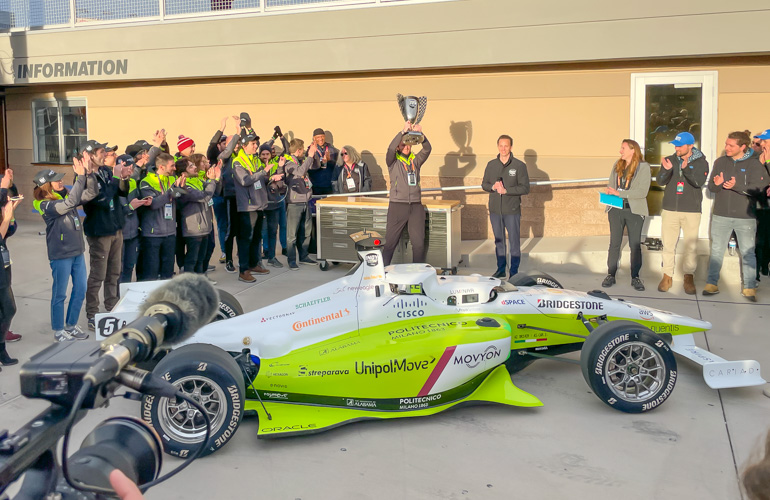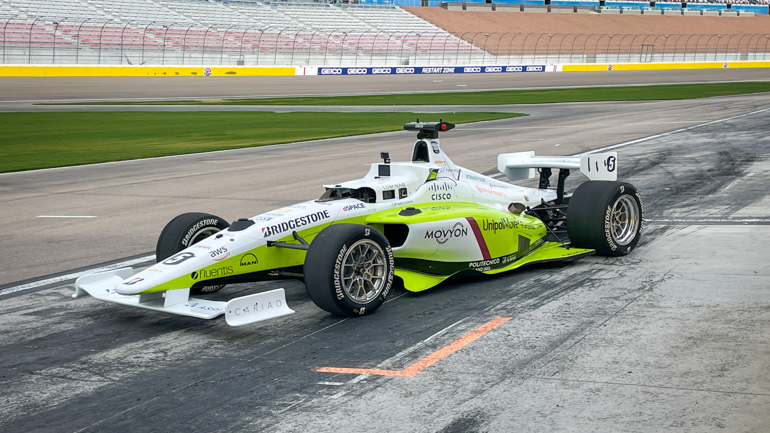|
Listen to this article  |

Team PoliMOVE celebrates at the awards ceremony for the 2023 [email protected] event at Las Vegas Motor Speedway. | Credit: The Robot Report
The second annual Autonomous Challenge @ CES was won by the Indy Autonomous Challenge (IAC) team PoliMOVE from Politecnico di Milano (Italy) and the University of Alabama (Alabama). The competition took place during week of January 1, 2023 with the final competition occurring on Saturday, January 7, 2023 at the Las Vegas Motor Speedway. Attendees of CES 2023 were able to attend and watch the event live, in person. Thousands of fans who weren’t able to attend the event in person watched a live simulcast via the IAC Twitch account.
PoliMOVE’s vehicle reached a top speed of 180 mph, which is a new autonomous speed world record for a racetrack. PoliMOVE competed against nine other teams from 17 universities in six countries. All of these teams were trying to break records for head-to-head autonomous racing. The Technische Universität München (Germany) team TUM Autonomous Motorsport came in second place in the close race. TUM was the winner of the inaugural IAC event, held at the Indianapolis Motor Speedway in October of 2022. PoliMOVE won the prior IAC @ CES event last year, on this same race track.
In the final head-to-head competition, PoliMOVE and TUM made more than a dozen laps around the track as the passing speeds continually increased. On the final lap, TUM spun out on turn 1 of the racetrack as it lost traction in the banked corner. The video below shows the exciting end of the race.
Rules of the IAC race
The IAC Competition Rules call for a single-elimination tournament with multiple rounds of head-to-head passing matches and a final round to decide the winner. The autonomous Dallara AV-21 racecars from each team took turns playing the roles of Leader (Defender) and Passer/Follower (Attacker) in front of a crowd of people from all over the world at CES. Passes were attempted at speeds that got faster and faster until one or both cars couldn’t make a pass.
In order to qualify for the head-to-head passing competition, the IAC rules said that each team had to do a high-speed time trial with an autonomous race car. Six of the nine teams that wanted to participate against each other were able to do so at Saturday’s race.

The Team PoliMOVE race car is ready for launch as it starts another winning day at the track. | Credit: The Robot Report
“Exactly 365 days later, we were so proud and excited to be back in Las Vegas for the Autonomous Challenge @ CES,” said Prof. Sergio Savaresi, team lead of Politecnico di Milano. “Today was a major step forward in speed, in the complexity of the race, and in overcoming challenging head-to-head situations. We are very glad for this success, for the contribution of the Indy Autonomous Challenge, and for all the teams in advancing the technology of A.I. drivers.”

The PoliMOVE race control team watches the monitors and action from the team pit during the competition. | Credit: The Robot Report
“We came to the world’s most influential innovation event this week, CES, to showcase to the entire technology ecosystem how this program and this competition is catapulting autonomous technologies forward,” said Paul Mitchell, president, IAC. “We’re harnessing the power of head-to-head competition to push and test the limits of autonomous driving to further the state-of-the-art technology in safety and performance of automated vehicles, and today we snagged yet another world record.”
Nine teams from 6 countries, representing 17 universities came to Las Vegas this week seeking to compete in the Autonomous Challenge @ CES.
- AI Racing Tech – University of Hawai’i (Hawai’i), University of California San Diego (California), Carnegie Mellon University, and University of California, Berkeley
- Autonomous Tiger Racing (ATR)* – Auburn University (Alabama)
- Black & Gold Racing* – Purdue University (Indiana)
- Cavalier Autonomous Racing (CAR)* – University of Virginia (Virginia)
- KAIST – Korea Advanced Institute of Science and Technology (South Korea)
- MIT-PITT-RW – Massachusetts Institute of Technology (Massachusetts), University of Pittsburgh (Pennsylvania), Rochester Institute of Technology (New York), University of Waterloo (Canada)
- PoliMOVE – Politecnico di Milano (Italy), University of Alabama (Alabama)
- TII EuroRacing – University of Modena and Reggio Emilia (Italy), Technology Innovation Institute (United Arab Emirates)
- TUM Autonomous Motorsport – Technische Universität München (Germany)
*Did not advance to Saturday’s final competition.
The racing isn’t easy
Several of the teams struggled to get their vehicles onto the racetrack throughout the week. Due to the costs involved in shipping the vehicles across the country, and the fact that almost all of the teams are spread out across the world, a lot of the development of the racing algorithms occurs in simulation.
In the weeks prior to each race event, the team members fly into the race site, set up their pits, and live in local hotels, as they transition from simulation to running their code on the physical vehicles. Several of the team struggled with mechanical problems that limited their time on the track for testing, qualifying, and competing on race day.

The AI Racing Team troubleshoots mechanical problems with the Dallara technicians as they work to get the vehicle ready for the quarterfinals. | Credit: The Robot Report
AI Racing Team is made up of team members from the University of Hawai’i (Hawai’i), the University of California San Diego (California), Carnegie Mellon University, and the University of California, Berkeley. This team, unfortunately, had bad luck with their vehicle on race day, due to transmission problems. However, the team eventually sorted it out enough that they were able to compete in the quarter-finals.

The MIT/PITT/RW mechanical team members worked almost 48 straight to repair the vehicle after a high-speed entanglement with the TUM vehicle earlier in the week. | The Robot Report
The other unfortunate mishap during the week occurred on Wednesday when TUM and MIT/PITT/RW were running some test laps together on the track. While TUM was attempting an overtake of MIT/PITT/RW at high speed, the vehicle lost traction and steered into the engine compartment of the MIT/PITT/RW vehicle. This caused substantial damage to the body, engine, and mid-vehicle sensor package on the MIT/PITT/RW vehicle. The result was a grueling 48 hours of work to rebuild the engine compartment, as well as the borrowing of some spare body parts to get the MIT/PITT/RW vehicle race-ready for Saturday.

Unfortunately, the team from Cavalier Autonomous Racing (CAR) didn’t qualify to race on Saturday, but the team still participated by parking the racecar in their pits. | Credit: The Robot Report
Next stop for the IAC is in Europe
From the [email protected] event in Las Vegas, the competition moves on to the next event at the Milan Monza Motor Show in June 2023 at the famous Monza raceway, located near Milan Italy. The race format will also evolve from oval racing to a road racing format. This promises to be more challenging for the race teams as they will now need to consider changes to the driving algorithms to run on a road course with both left and right-hand turns. It also will require a change in strategy for determining where on the Monza track to perform the overtaking maneuvers.
The Dallara AV21 racecars will continue to be the racing platform, and it hasn’t been determined yet if any changes might be made to the AV21 to prepare it for road racing. Based on conversations that I had with several of the team principles, the setup of the vehicle will have to change to balance it for the demands of left and right-hand turns. The current setup is optimized for the physics of oval racing and high-speed left turns.
Ayoub Raji, Technical Leader of TII Euroracing, said, “I consider the support of the MegaRide engineers on the aspects related to vehicle dynamics that we consider in the planning and control algorithms of our autonomous driving software to be of great value. The curves of the circuits have particular characteristics so it will be important to better identify the interaction between rubber and asphalt, an aspect with which MegaRide has a lot of experience. In addition, the collaboration also has long-term goals in the vision of even more complex races on guided tracks and not just oval.”
Aleksandr Sakhnevych, CTO of Megaride, said, “Many decision-makers and automotive key- players wonder how autonomous vehicles will affect future mobility. There could not be a better occasion to get a view on it, than something highly demanding as autonomous motorsport. We are proud to continue supporting our partners in the development of reliable and potentially affordable technologies which could provide huge savings and benefits, to win races today, to move people tomorrow.”
Credit: Source link


Comments are closed.